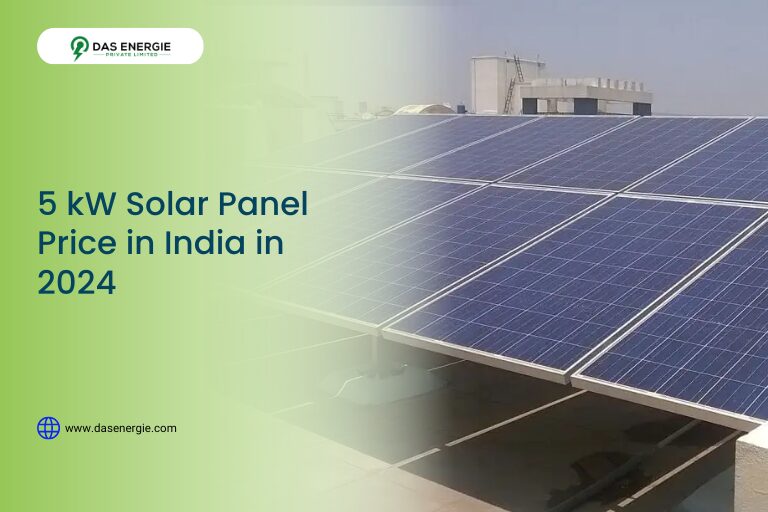


Do you know? You can save close to Rs. 5000 monthly with a 5 kW solar system. It will generate around 600 units of electricity monthly. The 5 kW solar panel price varies a little across brands. The type of panel is the crucial factor that influences the price of the panel. You can receive a subsidy of Rs. 78,000 for installing the solar system.
Table of Contents
ToggleFollowing are the major types of panels which can be used in a 5 kW solar system:
These panels were popular earlier but today they are regarded as outdated. Hence, we have not listed their price.
In mono-PERC panels, PERC technology is coupled with monocrystalline cells to boost output. Their average capacity is 550 W. You will need 10 mono-PERC panels for a 5 kW solar system.
Cost of Mono-PERC Panel: The price of a single non-DCR panel is Rs. 10,000 to 12,000 and of DCR panels is Rs. 12,000 to 14,000.
Cost of 5 kW Mono-PERC Panel: The price of 5 kW non-DCR mono-PERC panels is Rs. 1,00,000 to Rs. 1,20,000 and 5 kW DCR mono-PERC panels is Rs. 1,20,000 to Rs. 1,40,000.
A mono-PERC half cut panel produces electricity even when a shadow partly covers the panels. The part of the panel not covered by the shadow still produces electricity. The average capacity of a mono-PERC half cut panel is 550 W. You will need 10 such panels for a 5 kW solar system.
Cost of a Single Panel: The price of a single non-DCR mono-PERC half-cut panels is Rs. 11,000 to Rs. 12,000 and of DCR mono-PERC half-cut panels is Rs. 12,500 to Rs. 13,500.
Cost of 5kW Mono-PERC Half-Cut Panel: The cost of 5 kW non-DCR mono-PERC half cut panels is Rs. 1,10,000 to Rs. 1,20,000 and the cost of 5 kW DCR panels mono-PERC half cut panels is Rs. 1,25,000 to Rs. 1,35,000.
It is a mono-PERC half cut panel which can absorb sunlight from both directions. Bifacial panels can be of glass-to-glass or glass-to-transparent back sheet. The average capacity of a 5 kW solar panel is 550 W. You will need 10 such panels for a 5 kW solar system.
Cost of a Single Panel: The price of a single non-DCR mono-PERC half cut bifacial panels is Rs. Rs. 12,000 to Rs. 13,000 and DCR mono-PERC half cut bifacial panels is Rs. 14,000 to Rs. 15,000.
Cost of 5 kW Mono-PERC Half Cut Bifacial: The cost of 5 kW non-DCR mono-PERC half cut bifacial panels is Rs. 1,20,000 to Rs. 1,30,000 and the cost of 5 kW DCR mono-PERC half cut bifacial panels is Rs. 1,40,000 to Rs. 1,50,000.
TOPCon panels increase the efficiency of solar electricity generation by using a passivated oxide layer. The most common version of TOPCon panels is N-type. N-type panels are doped with phosphorous.
The average capacity of a TOPCon panel is 570 W. You will require 9 TOPCon bifacial panels for a 5 kW solar system.
Cost of a Single Panel: The price of a single non-DCR TOPCon bifacial panel is Rs. Rs. 14,000 to Rs. 15,000 and DCR TOPCon bifacial panels are Rs. 15,500 to Rs. 16,000.
Cost of 5 kW TOPCon Panel: The cost of 5 kW non-DCR TOPCon panels is Rs. 1,26,000 to Rs. 1,35,000 and the cost of 5 kW DCR TOPCon panels is Rs. 1,39,500 to Rs. 1,44,000.
Here are the solar panel prices at a glance for better comparison:
Type of Panel | Cost of 5 kW Panel (DCR) | Cost of 5 kW Panel (Non-DCR) |
Mono-PERC | Rs. 1,20,000 to Rs. 1,40,000 | Rs. 1,00,000 to Rs. 1,20,000 |
Mono-PERC Half-Cut | Rs. 1,25,000 to Rs. 1,35,000 | Rs. 1,10,000 to Rs. 1,20,000 |
Mono-PERC Half Cut Bifacial | Rs. 1,40,000 to Rs. 1,50,000. | Rs. 1,20,000 to Rs. 1,30,000 |
TOPCon Bifacial (N Type) | Rs. 1,39,500 to Rs. 1,44,000 | Rs. 1,26,000 to Rs. 1,35,000 |
Want to know more about the benefits of a solar system? You can check our blog on solar installation in home. There you will learn about all the components of a solar system, the factors you must consider before installing your solar system, and the types of solar systems you can install.
Das Energie Private Limited is India’s first and only platform to offer an online quotation service for solar system installation. You can check the quotations offered by your local vendors on our website.
From solar panels to a solar inverter, here are the major components of a 5 kW solar system:
Solar panels are the main components of a solar system. It converts sunlight into solar electricity by using photovoltaic cells. To decide which solar panels are the best for your solar system, you can compare their efficiencies.
Here’s how efficient different solar panels are:
Type of Solar Panel | Efficiency |
Mono-PERC | 20-21% |
Mono PERC Half Cut | 20-21% |
Mono-PERC Half Cut Bifacial | 20-21% |
TOPCon Bifacial (N Type) | 22-23% |
Solar electricity generated by solar panels is the Direct Current (DC). A solar inverter converts it into the Alternating Current (AC).
A mounting structure holds the solar panels in place and points them towards the sun. It must be strong and resistant to corrosion. Remember that your mounting structure must hold your solar panels for 25 to 30 years.
Wires from multiple solar panels transmit the solar electricity to the Array Junction Box (AJB). From there, a single wire takes the total electricity to the inverter.
The AC DB box protects your household appliances from voltage fluctuations. You need to install it between the household appliances and the inverter.
The DC DB box protects your inverter from voltage fluctuations. You will have to install it between your solar panels and the inverter.
To protect your solar panels from lightning, you have to install a lightning arrester. When lightning strikes, the lightning arrester will send the electricity to the earth via earthing. The height of the lightning arrester determines its efficiency.
You need components such as MC4 connectors, wires, and conduit pipes in your solar system. For example, MC4 connectors are used for connecting solar panels.
You must contact a DISCOM-empanelled vendor to install your solar system. At Das Energie Private Limited, we have scrutinised vendors against stringent criteria before onboarding them as installation partners. You must compare quotations for solar installations to get the best value for money.
Here’s a breakdown of the cost of installing a 5 kilowatt solar panel system :
| Solar System Component | Cost |
| 5 kW Mono PERC Half Cut Solar Panels (DCR) | Rs. 1,25,000 to Rs. 1,35,000 |
| Solar Inverter | Rs. 40,000 to Rs. 42,000 |
| ACDB | Rs.3,000 to Rs. 4,000 |
| DCDB | Rs.3,000 to Rs. 4,000 |
| AJB Box | Rs. 5,000 to Rs. 6,000 |
| Mounting Structure | Rs. 40,000 to Rs. 43,000 |
| Lightning Arrester | Rs. 2,000 to Rs. 2,500 |
| Installation Charge | Rs. 10,000 to Rs. 30,000 |
| AC Wire | Rs. 5,200 to Rs. 5,600 |
| DC Wire | Rs. 1600 to Rs. 1800 |
| Other Components | Rs. 55,000 to Rs. 57,000 |
| Total Cost | Rs. 2,90,000 to Rs. 3,30,000 |
Here we have given you a breakdown of the cost of 5 kW solar panel system installation. If you want to know more about the solar panel installation cost, you can read my blog on the topic.
You can get a subsidy of Rs. 78,000 for installing a 5 kW solar system under the PM Surya Ghar scheme. After availing of the subsidy, the cost of installing a 5 kW solar system will be between Rs. 2,12,000 to Rs. 2,52,000.
A 1 kW system can generate 4 to 5 units of electricity per day. So a 5 kW generates 20 to 25 units of electricity per day. In a month, it will generate 600 to 750 units of electricity monthly.
If you pay Rs, 8/unit of electricity, you will save Rs. 4,800 to Rs 6,000 monthly.
It is great that you are considering installing a 5 kW solar system. But if your power consumption is less than 200 units of electricity monthly, you could consider buying a 1 kW solar system instead. To know more, head to my blog on 1 kilowatt solar panel price.
Are you looking for the right vendor to install your solar system? You can get the best quotations for solar system installation at Das Energie Private Limited. Our DISCOM-empanelled vendors will ensure a seamless installation experience at an affordable price.
Installing a 5 kW solar system can reduce your bills to zero and earn you monthly electricity credits. The 5 kW solar panel price will vary according to the type of panel you buy. To get the best value for money, you must purchase either mono-PERC half cut panels or TOPCon N-Type panels.
Yes, you can get a subsidy of up to Rs. 78,000 for installing a 5 kW system under the PM Surya Ghar scheme. To get the subsidy, you must meet the eligibility criteria.
The three main types of solar systems are on grid, off grid, and hybrid. In an on grid solar system a grid stores the solar electricity. In an off grid system, a battery stores the power. A hybrid system stores the solar electricity in a battery and sends it to the grid as well.
The net meter measures the export of electricity from your solar system to the grid and the electricity you import from DISCOM’s grid to your home. After the month is over, you either pay for your net consumption or earn monthly electricity credits.
India has a vast potential for generating solar electricity. The government aims to generate 40 GW of solar electricity from rooftop solar installations by 2026. It will also help India to meet its international renewable energy commitments.
Assuming that you pay Rs. 8/unit of electricity, you can save Rs. 4,800 to Rs 6,000 monthly on your electricity bills.
Your best choices are mono-PERC half cut, mono-PERC half cut bifacial, and TOPCon bifacial panels. Of these, TOPCon panels are the most efficient and more affordable than mono-PERC half cut bifacial panels for a 5 kW system.
Mr Das’ expertise spans various aspects of solar energy, including photovoltaic technology, solar thermal systems, and energy storage solutions. He contributes profusely to our blogs to share his keen knowledge and expertise with those seeking information regarding solar system installation.
